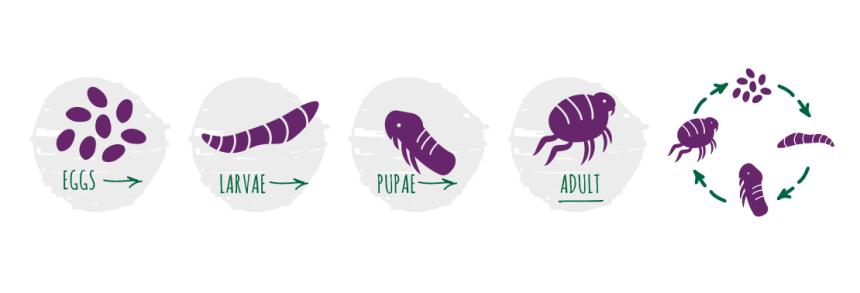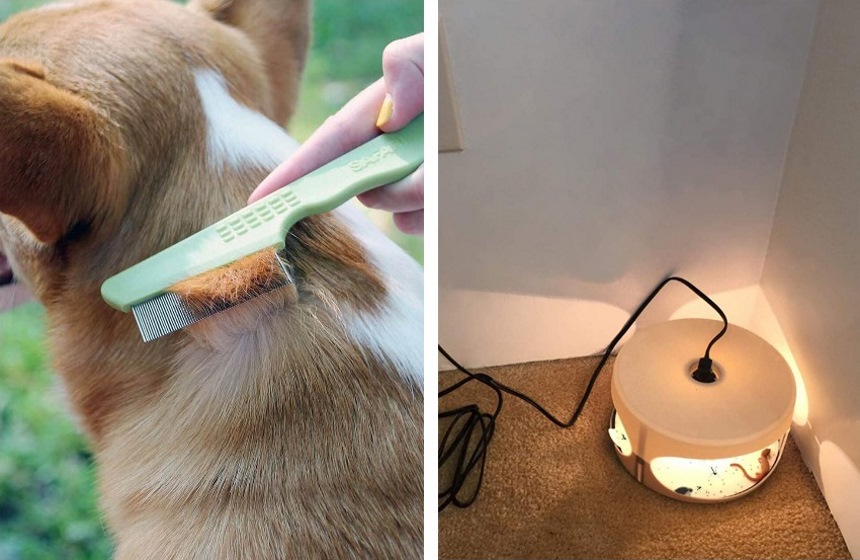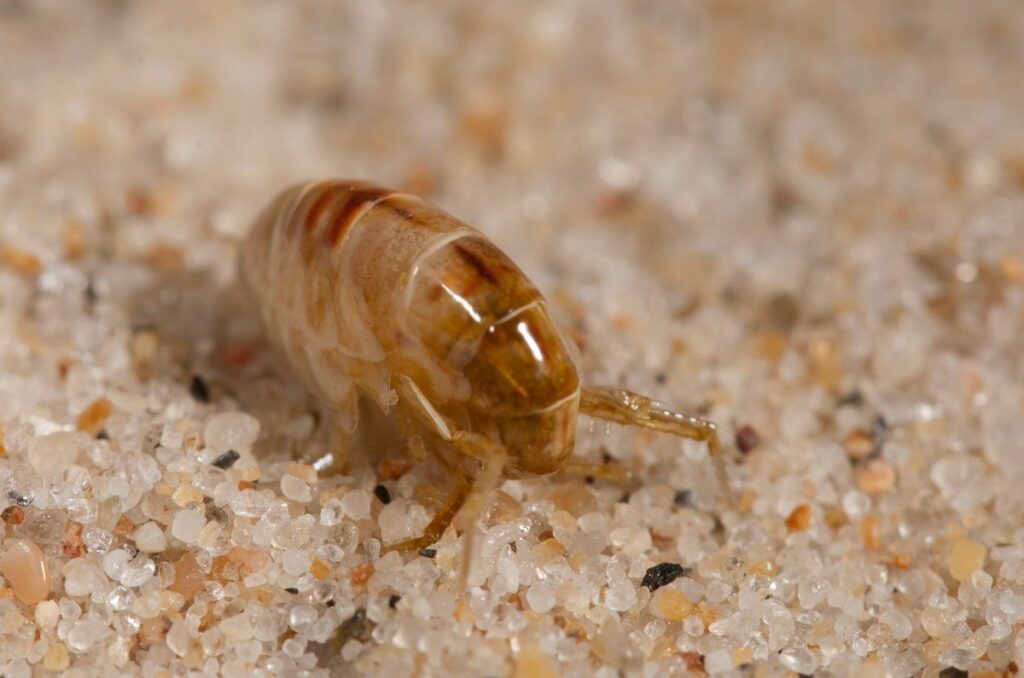

In this article, we will look at how fleas move – do they jump or fly? We’ll also discuss the signs of flea infestation and how they can be controlled.
Do fleas fly? This question comes to your mind when you see these tiny parasites on the body of your well-grown pets. Whenever similar occurrences happen, you think to yourself again, can fleas fly? Well, the answer is they don’t fly. They can only jump high – extremely higher than pests of their class.
They are no respecter of any class of animal; they bite and feast on any creature with fur. As much as you see fleas on your pets, they can also attack humans. They bite the human ankle and when they get their chance to jump to the hair, they don’t hesitate.
Do you want to know about how they move and jump so high despite being tiny? Do you want to know how they can be controlled so as not to disturb you and your pets? Keep reading this article.

Contrary to many people’s thoughts, fleas don’t fly in the air. They have no wings, hence their inability to move in the air. They are only capable of jumping high, so don’t mistake them for other insects that bite, have wings, and look like fleas.
The body of a flea when looked closely or examined under a microscope does not look alike to that of a bug. Fleas are like a mixture of an insect and a lobster. Fleas only have four legs, but strong ones that contribute to the way they jump.
Do fleas fly or jump? This question has been asked severally by pet lovers when they see their pets scratching their bodies because of the discomfort caused by fleas. You would begin to wonder how they got to the body of your pets – for instance, the collar of your dogs.
To know how fleas move, firstly, you must be able to recognize them when you see them – know them differently from other insects. How do fleas look?
Fleas are little, dark-brown insects that look like poppy seeds. They have four powerful legs (coxa, femur, tibia, and tarsus) that they use to jump and crawl around.
A flea remains in its cocoon until it hatches and takes its first jump out of it. A flea will only leave its cocoon when it notices that there is a blood meal nearby such as the movement of animals. Fleas don’t move around too often; they stay on a host until the end of their life cycle or when they are displaced. So, they crawl most times and only jump when they are on a hunt for a host.
However, while on a host, a flea might occasionally jump from one side to the other, but this is a major risk as any unplanned movement like the host shifting its body, means that the flea will fall off, and if the flea doesn’t find another host to feast on, it will starve to death.
Anytime we think of fleas, we have the image of the adult flea in our head, but fleas take some shapes before they are completely formed. Knowing the life stages of a flea can help you respond promptly to an incoming infestation. Disrupting their life cycle saves you from the havoc they cause!

Fleas have four life stages: egg, larvae, pupa (larvae in a cocoon), and adult.
Once an adult female flea is allowed to remain on a host and have a blood meal, the next agenda is to lay eggs. Flea larvae are made from their eggs as part of the flea life cycle; however, they are yet to be fully grown at this point. At this stage, they look like micro-slugs that require a longer period to mature. Because of this, they build cocoons to protect themselves and continue to grow. They remain in these cocoons until they are fully grown (adulthood stage).
As they remain in their cocoons, their metabolism reduces so that they don’t need to feed, yet remain alive. At this point, they concentrate fully on their growth. They can stay without moving in a cocoon for as much as weeks or months depending on their environmental conditions.
Note that there is no such thing as a baby flea. Fleas remain in their cocoon until they are fully-grown, hence adult fleas.
After emerging from the cocoon, an adult flea will immediately begin to feed as it has been deprived of food during the development stages. If a flea doesn’t get a pet or in some situations, a human to feed on, it will die.
Female fleas can’t reproduce unless they’ve eaten. Once they eat and get comfortable with their host, they begin to lay eggs, thus the birth of another flea generation. The fleas you see on your pets are adult fleas; they feed and lay eggs on them, and they don’t leave unless they are displaced.
Also, adult fleas’ appearances transform after they have eaten. A recently hatched adult flea is quite tiny, has a flattened body, and is dark in color, but when it has sucked enough blood, it transforms into the familiar flea shape and its color becomes lightened.

As previously said, fleas have a high jumping rate, they jump way higher than other insects in their class, hence why they are found on fully-grown pets and human hair. Sometimes, you would see them at the top of the head of your fully-grown pet and you would be left to ask: do fleas fly like gnats?
Fleas have very strong legs that ensure that they jump very high, but the main propeller of such height is the resilin present in their legs. The average height of a flea jump varies; it depends on the kind of fleas (cat flea, dog flea, sand fleas, human flea, etc.). But fleas can jump as much as 19 inches.
Pets (and sometimes, humans) are the major targets of fleas. Below are a number of ways you would know if your pets or you are suffering from flea infestation.

A few minutes after cleaning, you might notice that your pets are itching their body and you would be left to ask: do fleas fly around because you can’t seem to fathom how your pets got infested in a recently cleaned environment. Well, that’s because pets are the major carriers of fleas. Unless you clean your environment very well and your pets thoroughly, the infestation won’t stop.
An equipment that can be used to put an end to flea infestation is the use of TRAP-N-KILL Flea Trap – its heat attracts fleas from up to 25 feet away. It’s a verified method of putting an end to flea infestation.
Your major flea problem is solved when your pet is not infested. Use a flea comb to brush your pet, then soak the comb in soapy hot water to kill the fleas. After that, wash your pet with a flea shampoo and strictly adhere to the shampoo’s guidelines.
Apply a flea repellant after your pet has dried off. Visit your veterinarian to ensure that the treatments are effective. For further control and prevention, your veterinarian would most likely recommend the Vet’s Best Flea and Tick Home Spray. According to most pet lovers, it has proven effective on their pets and homes
Another control strategy is to vacuum your whole house. After that, throw the vacuum bag in the trash immediately. Don’t keep the vacuum bag inside your house because the fleas are going to spread again. In addition to this, wash all the materials (beddings, pillows, blankets, etc.) that your pet might have come in contact with.
If external animals like rats or snakes enter your home, use IGR for fleas like flea traps. Also, make sure you figure out how they make their way into your home, and block it.
Lastly, you might have to resort to calling a pest professional to give you a lasting solution to your flea problem.
Below, we answer more questions you might still have.
Out of the thousands of fleas that exist, only one of them can live on humans, and it is called the Pulex Irritans. Just like other fleas, it does not have wings which makes it unable to fly. The Pulex irritans is a rare and dangerous flea; it’s the only flea that can make humans its host.
Sand fleas don’t infest your pets or disturb your home like other fleas. They feed on seaweed, so they’re most likely to be seen in huge numbers on beaches where seaweed has washed up. Something similar that they have with other fleas is that they don’t fly, they only jump.
The dog flea is a very common type of flea. Fleas are typically drawn to dogs, they attract each other like magnets. Out of all fleas, they jump the most. However, they do not fly, they only jump high.
Cat fleas are the most common of all fleas. They feast on all kinds of animals. However, one thing every kind of flea including cat fleas cannot do is “fly”; they only jump.
Majority of the world population have been asking: do fleas fly? Well, it’s worth asking because of the way they make their way to tall pets and human hair. To answer the question, they don’t fly.
For more clarity, fleas don’t have wings, so there’s no way they could possibly fly. All they can do is to jump very high, all thanks to their strong four legs and the resilin present in them.
However, in this article, we have discussed the stages of flea life cycle, how far fleas can jump, signs of flea infestation, and how to control them when they attack.





